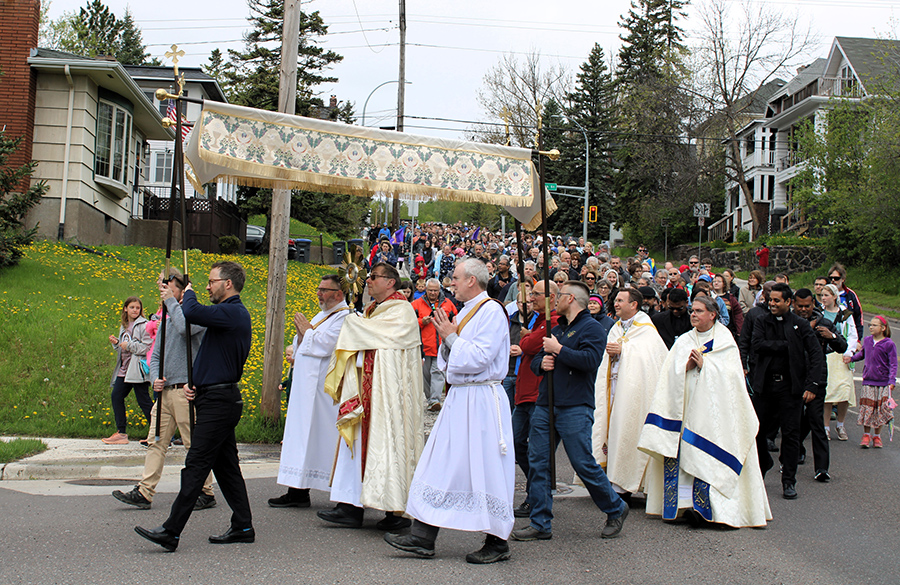
The Dioceses of Superior and Duluth teamed up for Mass and Eucharistic adoration May 21-22 in Duluth when the Marian route of the National Eucharistic Pilgrimage visited the city. See more photos inside. (Catholic Herald photo by Jenny Snarski)
Jenny Snarski
Catholic Herald Staff
As the final lead-up to the National Eucharistic Congress in Indianapolis this July, Catholics are invited to participate along four Eucharistic pilgrimage routes throughout the country, converging on the congress in America’s heartland.
The Marian Route, which started at the Mississippi’s headwaters in Northern Minnesota passed through Duluth May 21-22. The Diocese of Superior was invited to lead and take part in this national event.
Holy Hour, May 21
On Tuesday, May 21, Bishop James P. Powers led a holy hour of Eucharistic adoration at the Cathedral of Our Lady of the Rosary in Duluth. The Cathedral’s rector welcomed everyone present that evening, including Bishop Daniel Felton, the local ordinary, and Bishop Andrew Cozzens, who is committee chair for the National Eucharistic Revival initiative.
Bishop Powers incensed the exposed Eucharist and led an opening prayer. Diocese of Superior Dcn. John Grek proclaimed the Gospel account of the disciples on the road to Emmaus from Luke, chapter 24. Prayers of the faithful were offered and another lengthy period of silence took place before a solo piece performed by Superior’s Diocesan Chorale.
After the Eucharistic blessing, acclamation of the Divine Praises and Reposition, all present were invited to a reception and fellowship following the holy hour across the street at Stella Maris Academy.
Mass and Eucharistic Procession, May 22
Although the forecast included possible rain, Mass began with an overcast sky outside the cathedral. Duluth’s Bishop Daniel Felton was the presiding celebrant, with Bishop Powers and Bishop Cozzens concelebrating along with various priests, assisted by numerous deacons.
In Bishop Felton’s opening comments, he prayed that through the celebrations “all may be made one in the communion that we share.”
He started the homily by singing a verse of the Servant Song: “Will you let me be your servant, let me be as Christ to you?”
The bishop repeated Jesus’ words, that he did come to be served but to serve, and that greatest among you will be the servant of all. The call to service is a call to follow the Lord in his ministry.
Bishop Felton recounted his supper stop at a small restaurant, and how he overheard positive comments about the Eucharistic Conference he had just left in Bemidji. The comments came from a security guard who had worked at the event, and it made the bishop aware of the countless servants who made the conference possible in so many hidden details, and how they represented this servant Christ.
“Could we name any of these people?” he asked. Likely not, even though they had done so much, their efforts forgotten as we moved on to the next leg of the journey.
“All of those people have been an expression – an embodiment of Jesus,” he said, and they serve as reminders that we are to do everything for the honor and glory of God.
“The shadow side of serving others,” Bishop Felton continued, “is doing something for my own honor and praise.”
He issued a challenge to the pilgrims continuing on to Indianapolis and all present, to remember these servants, to lift them up in prayer and remember “how they were Jesus Christ to you.” How their service inspired and how their presence represented Jesus’ presence to us.
“The same is true of us,” he continued, “We’re continuing the pilgrimage of life… and I would challenge you and myself to, at the end of every day, think about the events of that day and to be mindful of someone who was there serving others.
“Be mindful of someone there serving who you don’t know their name. Do not forget them.”
We want to be like them, he said, as they are like Jesus for us. This experience can bring us to a sense of the honor and privilege of being a servant, as real as Jesus’ presence in the Eucharist.
Bishop Felton ended his homily singing again from the Servant Song, “Pray that I may have the grace to let you be my servant too.”
“We are pilgrims on a journey… We are here to help each other walk the mile and bear the load,” he said.
During the Prayers of the Faithful, Bishop Andrew Cozzens was acknowledged for his leadership and behind-the-scenes service, giving honor and glory to God.
After a brief break following Mass, the Eucharistic procession began with the church’s bells ringing out. The rosary was prayed by the crowd as the procession moved through residential streets with guided meditations and hymns sung in between mysteries. After the rosary, the leader prayed for God’s mercy to come down over the entire geographic area through which Jesus was being carried, for yearning hearts to find their rest in Jesus and interceding for blessings to come down on all the people, businesses and church congregations in the area. A period of silent procession was encouraged.
As the group neared the busiest section of the pilgrimage before crossing London Road and entering Leif Erickson park, the Chaplet of Divine Mercy was prayed. Police escorted the pilgrims for the entire route and provided traffic control as needed.
A final benediction was offered against the backdrop of Lake Superior, with Duluth’s Canal Park to the east and the City of Superior in the distance.
